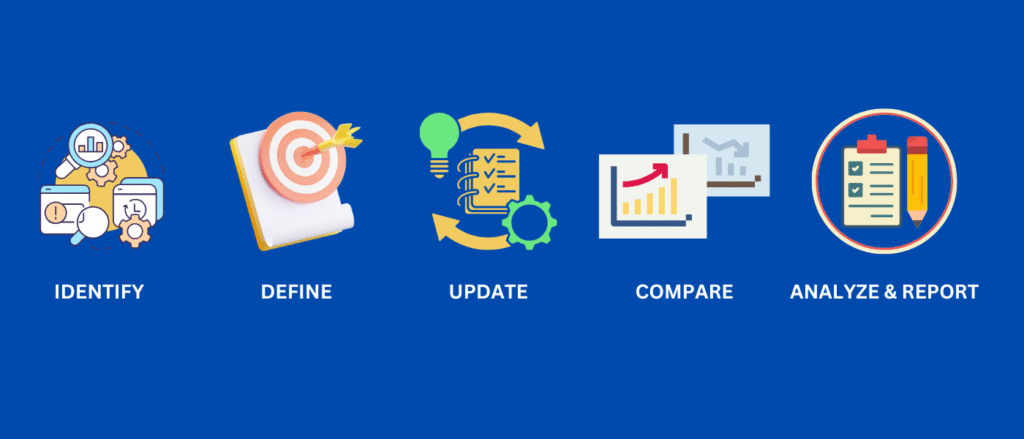Introduction
Imagine spending thousands of hours developing a software application, refining it further to perfection, speed, and efficiency.
However, before you set it free, how do you ascertain that it will perform like a winning champion? That is where baseline testing takes its place! It is somewhat like a memory photograph of your software performance, preserving all the fine details. Why?
Because when you want to upgrade your application in the future, you need to compare the newly obtained performance at a certain moment with the old one.
Think of detectives trying to read clues; baseline tests give companies the ability to read performance clue-revealing bottlenecks.
In this guide, we’ll explain what is baseline testing in software testing, and why it matters. Let’s get to it!
What Is Baseline Testing in Software Testing?
Baseline testing is creating a baseline defined as a reference point by capturing particular performance or function metrics of a system and then comparing such metrics with any other test results in the future to assess that system’s sustained functionality and performance over time.
So, for instance, you could take a fitness track over months. At first, you might weigh yourself, determine your body fat percentage, and measure your endurance levels.
A few months down the line, you’d repeat these procedures and consider the results with the baseline to see how much progress has been made.
The same effect would have been achieved with baseline testing in the application form on the software side, as it would ensure that the application is healthy and stable over time.
Key components of baseline testing include the following:
- Performance Metrics: It measures parameters like response time, throughput, and resource utilization.
- Data Analysis Benchmarks: Including math statistics w Apple devices when testing iOS applications to ensure calculation accuracy remains consistent across updates.
- Functionality Benchmarks: It validates that critical functions are working correctly.
- Version Comparisons: The latest version is checked against previous ones to establish differences.
Why Is Baseline Testing Important?
Baseline testing refers to an activity critical to making the software’s quality determined and reliable.

This is what makes it significant:
Early Detection of Performance Problems:
The greatest value of baseline testing is the one that catches performance problems usually earlier.
Imagine an example of adding new features to a web application where users would realize they are suffering from slowed-down page loads or server response times only when they begin to complain.
But when you take a baseline before adding the new feature, you can quickly detect any degradation in performance at the time when comparing the results after adding the new feature to this baseline.
Ensures Consistency:
This is especially true in cases where software has to run across versions.
In the case of running an online retail shop, where search functionality is fundamentally the heart of your customers, through baseline testing, you would ensure that each time the search algorithm is updated or optimized, that main feature retains its functionality.
Regression in performance can be detected and eliminated before it ever reaches the users.
Provides Support for Decision-making:
Another way in which baseline testing is of assistance to different parties is by providing informed decisions. Whether one is a project manager or top executive of product development, baseline data can ensure that changes and updates being made effects are known on the software.
This information will then determine whether to postpone a release or an improvement is still needed.
When Is Baseline Testing Performed?
Baseline testing is usually performed at some points in the software development life cycle:
Before Major Updates:
The best time to set up a baseline is before you make significant changes. It will then be possible for you to track exactly to what extent the updates have affected the performance.
For example, if you are introducing a new user authentication system, then you could measure the login times beforehand and then compare them afterward to ensure that there’s no regression.
During Performance Tuning:
Baseline testing during performance optimization is very important.
For instance, baseline testing measures the previously optimized performance of an app when improving its load-time optimization, which can be compared with post-optimization results.
As part of Regression Testing:
This testing checks that the existing features still work after a new deployment.
Baseline testing, too, can be carried out with regression testing to study the changes and ensure that the new features have not caused any unpredicted issues in the existing features.
How Does Baseline Testing Work? A Step-by-Step Guide
Implementing baseline testing is a simple process as follows:

- Identify the Scope
Before starting up the whole process of baseline testing, one knows exactly what one wants to measure; an identifiable function or something that matters by way of performance metrics.
For instance, an online banking app may focus on measuring transaction processing times, security protocols, and UI responsiveness.
- Define the Baseline
Finally, the current version of the software, where key performance and functionality metrics are taken. These should be gained using various testing tools such as performance monitoring systems, load testing tools, and automated testing frameworks. These should be considered as your baseline measures.
- Implement Changes or Updates
These will include changes or updates that you plan to implement on the software according to what you would like to achieve, such as bug fixing, addition of features, or system optimization.
- Compare to the Baseline
Changes having been made, run the same tests again and compare outcomes against the baseline. Search for performance or functional differences between tests. Any deviation from the expected performance indicates that a closer investigation must be conducted.
- Analyze and Report
In the event of deviations, determine their root cause. Is it the modification that is irritatingly hampering performance? Or has the newly added feature affected the reliability of the system? Capture all in a report that will now be shared with concerned stakeholders.
Real-world Examples of Baseline Testing in Action
Example 1: Website Performance Testing
Suppose a company has a website and needs to update its already existing site so that it can show new features for a better user experience. Before deployment, they conduct baseline testing on the current version to record:
- Page load times.
- Server response times.
- Error rates.
After updating, they rerun those tests and compare them if the post-update performance is slower than before. It will be possible to trace the cause of slow performance and apply fixes in the background before users notice it.
Example 2: Mobile Application Functionality Testing
A fitness application is launching a new sleep-tracking feature. During the testing phase, developers often use the best iOS emulator to test baseline performance across different Apple devices without needing physical hardware.
The team also monitors how math statistics w Apple’s HealthKit integration perform to ensure accurate data calculations remain consistent.
Before launching this new feature, the company conducts initial checks to ensure that the other core features of the application work as expected during baseline testing: fitness tracking and calorie count.
Testing will be performed again on the update to ensure that this new sleep feature does not interfere with other functionalities.
Thus, users can continue using their app without glitches, and the new feature works as expected.
Tools that are commonly used for Baseline Testing
Various tools can be used for baselining depending upon the software to be tested. When budget constraints are a concern, teams often search for the best free automation testing tools for web applications to establish their baseline metrics without significant investment.
- JMeter: This is designed primarily for performance baselining and is used for web-based applications. Load time measurement along with server response time and some more parameters can be checked using the application.
- Selenium: This is the leading tool for testing web applications in an automated way including functionality testing and UI-specific features can be tested before and after changes.
- LoadRunner: Loadrunner is the bulkiest tool available for enterprise applications and is used to monitor different performance matrices and compare them with the baseline results.
- Custom Scripts: You can write your scripts using either Python or JavaScript for capturing and comparing the baseline data.
Challenges of Baseline Testing
Baseline testing is worth its chore. Some challenges include:
- Selecting the Right Metrics:
Performance and functionality metrics to be chosen for measurement are very elusive. This should be based on which aspects would potentially be most critical to user experience and system stability.
- Dynamic Environment:
Cloud or distributed systems have changing environments such as network changes and updates on hardware; hence identification of stable baselines by such performance metrics is very challenging.
This challenge extends to mobile testing where even the best iOS emulator might show different performance metrics compared to actual devices, making baseline establishment more complex.
- Resource Intensive:
The process of identifying a good baseline requires a lot of effort, especially in complex systems. Sufficient time should be allocated to adequate testing and analysis.
Best Practices for Effective Baseline Testing
- Start Small: Many programs could be very helpful in providing initial testing of small meaningful features or any performance metrics.
- Automate the testing process: JMeter or Selenium, which are among the best free automation testing tools for web applications, might automate the tests for the user to save time during testing and comparison.
- Regularly Update Baselines: The software may change to require an update in a baseline to present the new functional and performance capability of the system.
- Involve people associated: Key stakeholders should be involved to share the associated results with those stakeholders, such as product managers and developers so that their expectations can also be aligned through communication.
How Baseline Testing Helps Businesses

Baseline testing offers many advantages to businesses:
- Optimizing User Experience: This is by maintaining a consistent performance that does not frustrate users through long delays or nonfunctional features.
- Cost Reduction: The cost of fixing a problem is significantly lower if baseline testing catches the problems before the software is released to users.
- Improved reputation: To be trusted, users need to see reliable software behind their firm’s reputation, which in turn leads to a greater number of satisfied clients.
Conclusion
So, what is baseline testing in software testing? It is your method of assuring software reliability through baseline measurements of functionality and performance. For businesses and users, baseline testing represents trust that upgrades will add functionality without detracting from the user experience.
You have hence learned how baseline testing works, its importance, and the benefits to developers and end users. Whether you are directing a software project or merely taking an interest in the process, baseline testing will be one of your cornerstones for delivering high-quality software solutions.
FAQs
What is the primary purpose of baseline testing in software development?
To establish performance and functionality benchmarks for comparison with future test results.
How does baseline testing aid in the identification of software problems?
It detects deviations from baseline, which signal possible performance or functionality problems.
When is the most appropriate time to start baseline testing in the project lifecycle?
At the beginning of a project or before major upgrades or modifications.
What are the challenges involved in conducting baseline testing?
The establishment of proper benchmarks and managing changes due to variance in a dynamic environment.
What are some of the industries that stand to gain the most from baseline testing?
IT, e-commerce, and any other industry that is dependent on predictable software behavior.







